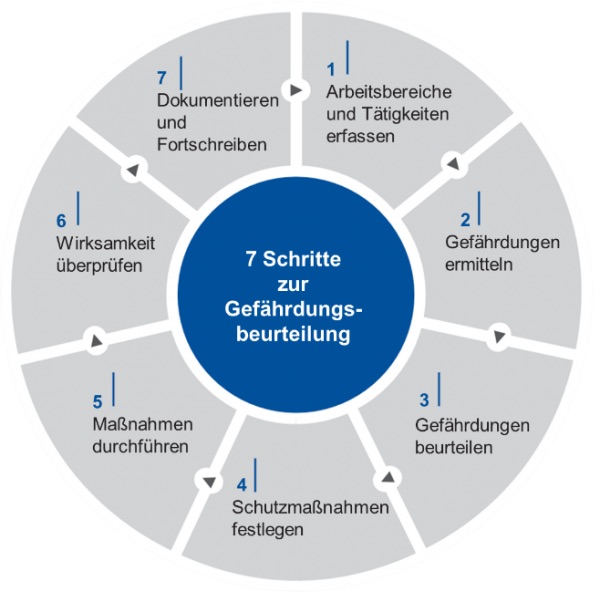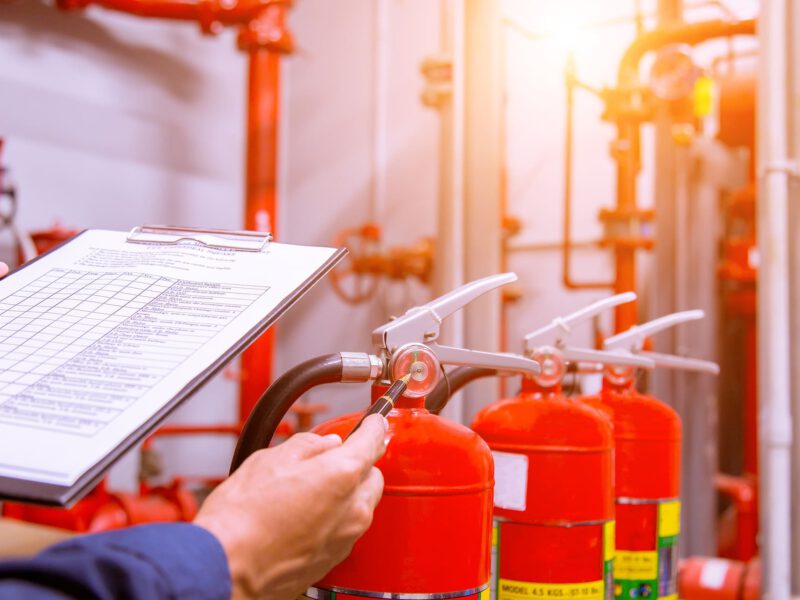
Plant and machine safety
To ensure the safe operation of your systems and machines and effectively prevent risks such as accidents, downtime and environmental damage, it is crucial to keep your systems up to date with the latest technology (‘state of the art’). CE conformity plays a central role in this and is indispensable for legally compliant operation.
However, the safety-related conversion of plants and machines can become a financial challenge if it is unstructured or inadequately planned.
With a structured target/actual analysis and a clear process concept, you can create a solid foundation for implementation and cost control. This approach helps you to plan your investments in a targeted manner and ensure that safety requirements are met without unnecessary expenditure.
We, the HSE engineers, provide you with professional support in the following areas:
Safe operation of old machines: What you need to know about CE marking and legal requirements
Many companies still operate a large number of old machines that were placed on the market before 1 January 1995. In principle, these older machines, for which there was no obligation to provide CE marking or a declaration of conformity when they were first placed on the market, may continue to be used or placed on the market again. They often function perfectly for decades and fulfil their purpose.
However, when it comes to safety, the current minimum legal requirements also apply to old machines. These must always be complied with in order to ensure safe operation.
The Industrial Safety Regulation (BetrSichV) regulates the operation of machines and work equipment. It states:
‘The employer must take the measures required in accordance with the general principles of Section 4 of the Occupational Safety and Health Act to ensure that employees are only provided with work equipment that is suitable for the conditions at the workplace and that safety and health protection are guaranteed when used as intended.’ (Source: BetrSichV)
For old machines without CE marking (before 1 January 1995), this means:
Old work equipment does not necessarily have to be replaced if the state of the art has advanced.
However, the employer is obliged to review their risk assessment in light of the latest technical developments and, if necessary, to take additional protective measures to ensure the safe operation of the machines (Section 3 (7) in conjunction with Section 4 (1) BetrSichV). An example would be the retrofitting of safety devices.
Our services include:
- Determining whether a machine is an ‘old machine’ or a ‘new machine’
- Assessing whether there are any significant changes that would lead to reclassification
- Evaluating compliance with the minimum safety requirements for old machines
- Carrying out the conformity assessment procedure for new machines
- Preparing risk assessments to ensure safe operation
Product safety in accordance with Section 3 of the Product Safety Act (ProdSG): Protection of safety and health
According to Section 3 of the Product Safety Act (ProdSG), which regulates the ‘general requirements for product safety’, a product may only be placed on the market if it does not pose a risk to the safety and health of persons when used as intended or in a foreseeable manner.
This applies in particular to the following areas:
- Product design: Products must be designed and manufactured safely to prevent hazards.
- Placing products on the market: Products may only be offered on the accessible market if they comply with legal safety standards.
- Displaying products: Safety precautions must also be taken when presenting or displaying products.
- Commissioning of products: Before using a product, it must be ensured that it meets the current safety requirements.
- Labelling of products: Products must be correctly labelled to ensure safe use and enable traceability.
As experts in product safety and CE conformity, we support you in complying with the legal requirements of the ProdSG and bringing your products safely to market.
CE marking and EC conformity assessment procedures: Safety and compliance for machinery and equipment
Since 1 January 1995, manufacturers in the European Union (EU) have been required to carry out an EC conformity assessment procedure for machinery, equipment and electronic devices. Responsibility lies with both the manufacturer and, in certain cases, the operator. With the CE marking, the manufacturer confirms that its machinery, equipment or electrical devices meet all necessary safety and health protection requirements in accordance with the Machinery Directive 2006/42/EC.
The CE marking is not only required when machinery is first placed on the market, but also when significant changes are made. Examples of this include:
- Interconnection of machines: When several machines are connected to each other in order to work together.
- Combination of machines: When machines have a common control and protective device and are considered as a whole.
In such cases, the machine operator acts as the manufacturer in legal terms and must carry out the conformity assessment procedure.
We, the HSE engineers, support you in carrying out the EC conformity assessment procedure and all associated measures. With a standardised and structured concept, we ensure that you meet all legal requirements, including the Industrial Safety Regulation and the Machinery Directive.
Our range of services includes:
- Clarification of the facts: old machine, interlinked machines or group of machines
- Implementation of the Machinery Directive 2006/42/EC
- Research and selection of relevant directives and standards
- Risk assessment according to ISO 12100 & ISO 13849
- Determination of residual risk
- Review and optimisation of operating instructions
- Preparation of technical documentation
- Support during the CE marking process
If we can help you with this process, please feel free to contact us.
Risk assessment: An essential component of occupational health and safety
We all carry out risk assessments all the time – often without even realising it. Recognising and assessing risks is as much a part of everyday life as eating and drinking. But while we can draw on personal experience in our private lives, risks in the workplace are not always immediately apparent.
That is why the law requires employers to conduct a systematic risk assessment to identify all work-related hazards, define appropriate measures and instruct employees accordingly. Risk assessment is a fundamental tool in occupational health and safety and forms the basis for the humane design of workplaces.
The goal: to identify accident and health hazards for employees or uninvolved third parties and take appropriate protective measures. Hazards should be avoided as far as possible or, if this is not possible, reduced to an acceptable and controllable risk.
Input for risk assessment:
- Measurements
- Operating instructions
- Safety data sheets
- Regulations and rules

Fig. Risk assessment
Output of the risk assessment:
- Operating instructions
- Personal protective equipment (PPE)
- Instructions
- Occupational health precautions
- Labelling
We, the HSE engineers, support you in creating a company-specific risk assessment. Together, we develop a practical standard that gives you a clear overview of the main hazards in your company and suggests specific measures to minimise risk. A systematic approach to the analysis, evaluation and development of measures provides you with a solid foundation for safe operation in your company.
Operating instructions for occupational safety: Clear guidance and practical assistance on site
Operating instructions are an indispensable piece of documentation for occupational safety. They are based on the risk assessment and serve as guidance and practical assistance for all employees and third parties on site. They contain specific instructions on the safe handling of work equipment and hazardous substances and help those affected to behave correctly at all times.
According to Section 14 (1) of the Hazardous Substances Ordinance (GefStoffV), employers are obliged to provide employees with written operating instructions that take into account all relevant aspects of the risk assessment (according to Section 6 GefStoffV). These instructions must be accessible in understandable language and form so that all parties involved can understand the safety requirements.
Our services include the creation and updating of operating instructions tailored to your specific operational requirements. Together, we ensure that your operating instructions meet all legal requirements and strengthen occupational safety in your company in the long term.
Employee training in occupational safety: Safety through regular training courses
According to Section 12 (1) of the Occupational Safety and Health Act (ArbSchG), employers are obliged to provide their employees with regular and comprehensive training on safety and health protection in the workplace. This training must take place during working hours and without any reduction in pay for the employees.
The initial training forms the basis for all further safety training and teaches basic occupational safety rules. It is required upon hiring, when there are changes in the scope of duties, and when new work equipment or technologies are introduced, and must be repeated regularly (Section 12 ArbSchG).
Although the Occupational Safety and Health Act does not specify fixed intervals for repeating the training, the intervals are based on operational requirements and the risk assessment. However, special occupational safety regulations and accident prevention regulations (UVV) require half-yearly (e.g. Section 20 DruckluftV) or annual training in some cases (e.g. DGUV Regulation 1 and Section 14 (2) of the Hazardous Substances Ordinance).
Our range of services includes comprehensive support in the areas of occupational safety, fire protection, environmental protection and energy:
- Creation of customised training materials
- Review and compilation of all necessary training topics
- Creation of a training matrix for clear training intervals
- Implementation of practical employee training
With our needs-based training courses, you can ensure that all legal requirements are met and that your employees are always up to date on occupational safety matters.
If you need support with training, please do not hesitate to contact us.
Inventory and risk assessment: Fundamentals for occupational safety, fire protection and environmental protection
A thorough inventory with a detailed risk assessment is the most effective method for obtaining an accurate picture of the company or building on site. This should be carried out in a structured and careful manner, ideally with professional support and an internal contact person who is familiar with the daily routines and technical equipment.
Our service includes a precise recording of the company, building and equipment inventory in terms of occupational safety, fire protection and environmental protection. The more detailed the inventory, the more targeted tenders for future service providers can be formulated, for example.
The results are documented in writing in the inventory and supplemented with photos to record technical data, quantities, condition and possible defects. We place particular emphasis on solution-oriented consulting and the elimination of identified defects.
Optimised support for cost savings in occupational health and safety, fire protection and environmental protection
Well-organised and needs-based support is the key to cost savings and efficient processes within your company. With our needs analyses, we help you to accurately assess the current status of your occupational health and safety, fire protection and environmental protection (HSE: Health, Safety, Environment) measures.
Based on the results of the analysis, we develop a tailor-made concept for your company that specifically addresses the areas where your previous measures fall short. In this way, we identify the causes of planning errors or deviations and thereby optimise your operational processes.
Our goal is not only to leverage savings potential through individual HSE support, but also to strengthen safety and sustainability in your company in the long term.
Safety and efficiency in technical inspections, audits and turnarounds
A technically flawless condition is not only crucial for minimising downtime in industrial plants, but also ensures safe and economical operation. To guarantee this, regular inspections and audits (known as turnarounds or TARs) are essential. These maintenance measures often cause downtime and thus a temporary halt in production, during which any additional expenditure can lead to economic losses. A delay during the turnaround can also increase the risk of accidents or safety hazards, which is why careful safety monitoring also plays a central role from an economic point of view.
We, the HSE engineers, offer comprehensive support for all safety-related projects in the context of overhauls, shutdowns and turnarounds. Our team accompanies you during the planning and execution phases to ensure the safety and efficiency of your project.
Our range of services includes:
- Safety monitoring of trades in (petro)chemical and industrial plant construction
- Provision of a safety specialist for external contractors
- Training and specific instruction
- Further training for supervisors in the individual trades
- Project-specific support in HSE management
- Preparation of company-specific documents, such as release certificates
With our expertise in HSE management (health, safety, environment), we ensure that your project runs according to plan, safely and efficiently.
Lockout/Tagout (LoTo): Protection against hazardous energies during maintenance and repair work
With increasing automation and the use of enormous amounts of energy in production processes, the potential dangers for employees are also increasing. Employees are exposed to life-threatening energy sources, especially during maintenance and repair work or when necessary interventions are required. A standardised protection system such as ‘lockout/tagout’ (LoTo) helps to minimise these hazards.
The LoTo system is used to control hazardous energies such as mechanical, electrical, hydraulic, pneumatic, chemical, thermal and explosive energies during interventions in hazardous areas. Equipment is mechanically locked and visually marked to create a safe working environment.
Although there is no direct legal obligation for a LoTo system in Europe, companies comply with legal requirements such as DGUV Regulation 3 § 6 and BetrSichV § 10 by using one. These regulations emphasise the need to carry out work on live or active parts safely and to secure work equipment against unwanted movements.
The LoTo system covers two aspects of application:
- Safe design of work equipment such as machines and systems when placing them on the market, which is particularly relevant for manufacturers, importers and distributors.
- Safe handling of sources of danger during activities that require intervention in danger zones, whereby responsibility lies with employers and managers.
Our services: We provide comprehensive support in the planning and implementation of a LoTo system that is tailored to the individual requirements of your business. Feel free to contact us at any time.
Safe maintenance and repair work: protection against invisible hazards
Employees are exposed to a variety of potential hazards during maintenance and repair work, many of which are not immediately apparent. Sources of danger can include work equipment, machines, systems and other people in the vicinity. A particular challenge is the interactive hazard, which also affects personnel in the vicinity of the work area.
The Industrial Safety Regulation (BetrSichV) regulates the requirements for the maintenance of machines and systems, and this is specified in more detail by Technical Rules for Industrial Safety (TRBS), such as TRBS 1112 – Maintenance and TRBS 1112 Part 1 (Explosion hazards during maintenance work).
We at HSE-Ingenieure GmbH support you in developing safe and efficient maintenance measures. We systematically analyse the hazards and develop tailor-made protective measures.
Our services include:
- Determining the scope of maintenance measures
- Support with risk assessment
- Creating safe work processes, including permits and lockout systems
- Securing the work area through labelling
- Selecting suitable tools and personal protective equipment (PPE)
- Training of supervisory staff, especially at external companies
- Establishing clear communication channels between maintenance and production personnel
- Support with instructing all parties involved
With our comprehensive expertise, we ensure that your maintenance work is carried out safely and in compliance with regulations, and that occupational safety is guaranteed in the long term.






